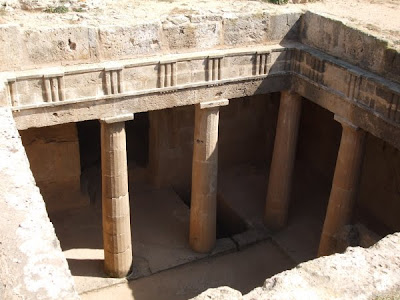Paphos used to be the capital of the island until it moved to Nicosia.
There is a defenate British influence with everything from UK style supermarkets to stores like Marks & Spencer, Debenhams & Next in the area.
Map Location :-
View Larger Map

Whilst not the largest of the beach front resorts of the island, it has all the normal attractions plus a few unusual ones.
4Paphos waterfront
4Paphos Castle
4Archaeological Park
4Tomb of the kings
4Covered market
4Boat trips
Transport - Buses are very good as an example one way trip from Coral Bay to Paphos harbour or Coral Bay to Paphos market 1.5 euro each way. (March 2010)
Taxis there are an abundance of them. You can pre-book one at your hotel or taxi centres. Beware they do try and poach you from bus stops but they are not cheaper.
Paphos Castle (Fort)
More of a harbour fort than a castle, there were 2 of these built but sadly this is the only accessible one as the other is now a ruin.
The small fort which stands on the ancients mole at the western part of the Nea Pafos was included in the coastal defence of Cyprus.
It is in fact a Frankish Tower within a Venetian wall
Not a lot to see inside, but worth the couple of euros to climb the steps in side to the top for the view.
On Sunday's from Easter there are music events in front of the fort. You can pick up a leaflet on arrival at Paphos Airport.
The Archaeological Park
This is a UNESCO World Heritage site with some 14 floors in a covered area as well as the open air displays.
The detail of the mosaics are just stunning. In order to preserve them having recently been discovered, 2 of the sites have been re-covered. However you do get to see images of them in the information centre.
You will need to allow at least a couple of hours to look round them all.
Tomb of the kings
The name of the site is misleading, apparently there is no evidence of any royalty buried here. Rather, the site was the final resting place of about 100 Ptolemaic aristocrats who lived and died in Paphos beginning in the 3rd century BC.
à bientôt















No comments:
Post a Comment